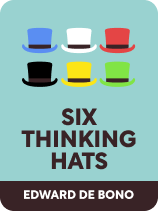

This article is an excerpt from the Shortform book guide to "Six Thinking Hats" by Edward de Bono. Shortform has the world's best summaries and analyses of books you should be reading.
Like this article? Sign up for a free trial here .
What is yellow hat thinking from Six Thinking Hats? What mode of thinking does the yellow hat represent?
The yellow hat is the constructive hat. This means the wearer’s job is to provide proposals and suggestions to the rest of the team while staying grounded and focusing on improvement.
Keep reading to learn how to use the yellow hat in your decision-making process.
The Yellow Hat
The yellow hat is the constructive hat. Yellow hat thinking is positive and concrete. You can remember this easily: Builders often wear yellow hardhats when working on new buildings, and yellow is the color of sunny optimism.
While some people are naturally disposed toward yellow hat thinking, for many of us it doesn’t come naturally—and it’s typically not taught well in schools and universities. Most people could use some consistent, focused practice to strengthen their yellow hat thinking abilities.
Yellow Hat Questions
While you’re wearing the yellow hat, consider these questions:
- What’s the silver lining here?
- How do we benefit from this?
- What happens if… (positive event)?
- How can we make this work?
- What proposal can I put forward to solve this?
- What’s the best possible outcome?
Yellow Hat Data
As with black hat data, yellow hat data is based on logic. Under both the black and the yellow hat, you’re considering ideas in light of your and other people’s past experiences. But this time, instead of thinking about everything that’s gone wrong in the past, you’re thinking about what’s worked.
Yellow hat contributions are about improvement. Proposals, for example, are classic yellow hat contributions. Proposals take a problem and set out ways to fix it. They take suboptimal situations and provide concrete, well-reasoned, solidly grounded suggestions for improvement. The yellow hat is concerned with generating proposals, finding sound reasons why proposals are likely to work, and developing strong proposals further.
Yellow hat contributions don’t have to be flashy. Simple, obvious suggestions are just as valuable as revolutionary ones. In fact, you may choose to save this type of serious out-of-the-box thinking for the green hat.
Yellow Hat Thinking vs. Blind Optimism
Yellow hat thinking is positive and optimistic, but ideally it’s also grounded in evidence and logic. “Don’t worry, even though things look bleak, everything’s going to be all right” isn’t genuine yellow hat thinking—it’s blind optimism.
In practice, the dividing line between blind optimism and a tiny but exciting possibility can be difficult to see. There are examples everywhere of people who started new ventures based on improbable dreams and succeeded. So how can you tell what’s viable yellow hat thinking and what isn’t? The answer is to think about the next step. If your plan requires a great deal of luck to work (for example, happening to get the attention and interest of a large investor), it’s a pipe dream. Set it aside. However, if you can see a clear path forward that’s mostly composed of your own efforts, the proposal is worth developing further.
To manage yellow hat probabilities intelligently, consider using a probability spectrum:
- Definite
- Very likely
- 50-50
- Possible
- Very unlikely
- Impossible
Next to each yellow hat contribution, note down where it stands on the probability spectrum and use that to help guide your decision.
Value
Yellow hat thinking can feel like panning for gold. You’re actively searching through a proposal or idea and looking for something valuable. In black hat thinking, you scan for weak points. In yellow hat thinking, you scan for opportunities. What has potential here? Where are the hidden footholds? What can you build on?
How to Use the Yellow Hat
- Because most people have never been trained in yellow hat thinking, it might take a little while to get the hang of it. It may help to think of it as the opposite of black hat thinking: Wherever you see strong points, highlight them. Wherever you see weaknesses, try to build them up instead of tearing them down.
- Consider using the yellow hat directly after the black hat to deliberately strengthen the weaknesses that have been identified by the black hat.
Advice for Facilitators
- Yellow hat contributions can be tricky to monitor, as the borders with the red hat (positive emotions) and the green hat (new ideas) can be fuzzy. Don’t be too rigid about policing this line—if a contribution seems to belong elsewhere, just raise the issue of whether it might be better to address later on under another hat.
- It can also be difficult to put your finger on the difference between yellow hat, black hat, and white hat contributions, because when written down they can all look very similar. The difference between these three hats is context. Let’s say you’re looking to construct a building in a particular neighborhood. Under the white hat, someone has provided the following information: “Planning regulations in this neighborhood stipulate that all new buildings be below eight stories.” If your goal is to build a skyscraper, this piece of information fits under the black hat: It’s a flaw in the design of your project, and means the project will have to be either reworked or relocated. But if your goal is to build an eight-story building with a gorgeous view from the top, the planning regulation fits under the yellow hat: It’s a sound reason why the project is more likely to succeed.
Exercise: Try on the Yellow Hat
Work with the yellow hat on a problem of your choice.
- Consider the project or initiative that you’ve been thinking about in previous exercises. What design flaws and weaknesses did you identify with the black hat? List the main ones. For each flaw or weakness, put on your yellow hat and see if you can find ways to strengthen or overcome the weakness.
- Think again about this project or initiative. What’s the underlying problem that it’s trying to solve? Can you come up with another way to solve it?
- What’s the best possible outcome for your project? If everything goes right for the project, what would that look like?

———End of Preview———
Like what you just read? Read the rest of the world's best book summary and analysis of Edward de Bono's "Six Thinking Hats" at Shortform .
Here's what you'll find in our full Six Thinking Hats summary :
- A handbook for training people to think more efficiently and productively
- An explanation of each of the six thinking hats created by Edward de Bono
- How to calm your inner critic and dramatically cut your decision-making time






